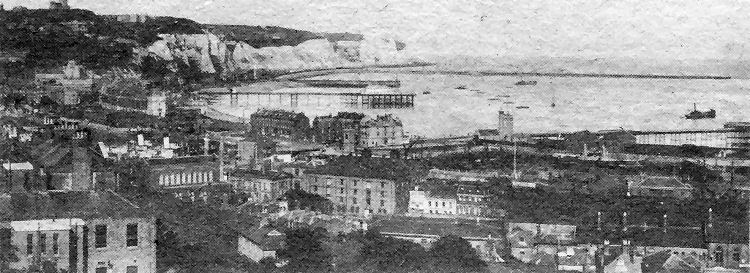Page Updated:- Sunday, 07 March, 2021. |
|||||
 Published in the Dover Express, 29 February, 1980. A PERAMBULATION OF THE TOWN, PORT AND FORTRESS. PART 63.
THE PACKET YARD The remaining part of this side of the street Is associated with the "Paris“ Hotel, which occupied the position now covered by the extensive buildings or the Dover Packet Yard. The Packet Yard was first utilised by the late Mr 3. C. Churchward, in the year 1854, for keeping his steamboats in repair, when he had the Dover and Calais mail contract; it was afterwards largely developed by the London, Chatham and Dover Railway Company to keep in going order their fleet of steamers, which ran the Dover and Calais mail and passenger service, and subsequently used for repair work to steamers used on both the Dover and Calais and the Folkestone and Boulogne services of the Southern Railway.
VANISHED SNARGATE STREET The rest of this description of Snargate Street deals with the part that has been pulled down, the sites of the buildings referred to being now the actual roadway. This was widened to 50ft. and elevated a few feet above the level of the quay side of the Wellington Dock. The properties on the cliff side now possess sea views, whilst foot passengers in this part of Snargate Street not only have that privilege, but also get a better impression of the cliff scenery. The necessary Parliamentary powers to demolish the property concerned were obtained by the Harbour Board in 1928. They undertook to give the land necessary to widen the road and pay the town £7,000 to carry out the road-making. Work started in the autumn of 1928, and was completed in 1930. In connection with this change there disappeared, when the Commercial Quay houses were pulled down, “The Barley Mow,“ a hostelry famed among sailors, the "Union Tavern," “The Golden Anchor,“ and the “New Commercial Quay" Inn. The description of the part that is gone follows the original edition of this book, with a few alterations in tense. On the sea side of the street, the “George“ Inn, which occupied the corner site, was a very old established Inn, dating from the early days of the House of Hanover. In the Dover Improvement Act of 1835, it was scheduled to come down, to widen the approach to the Victualling Yard from the bottom of Snargate Street; but lack of funds prevented the Improvement Commissioners from effecting their purpose. This was done in 1909, to give a better approach for the old Corporation trams.
EARLY PRINTING OFFICE A little higher up, at No. 86, the famous Albion Library was conducted by Mr G. Ledger, in the year 1782; and here was printed and published, in 1799, the original “Historical Sketch of Dover,“ which, in its preface, is said to be “the first book ever printed in the town it endeavours to describe.“ The sketch was reprinted at this library, with some additions, in the year 1807. First and second editions appeared prior to the publication of Lyon’s “History of Dover," which was printed in the same office. Here, also, was published, in 1825, Dover’s first newspaper, the Cinque Ports Herald. In 1820, this library was conducted by Mr Hendry, who had attached to it a reading room, the first one established in Dover; and he was succeeded some twenty years later by Mr Henry Harris. At No. 66 Snargate Street (which was approximately opposite the Church of Our Lady and St Martin), about the commencement of Queen Victoria’s reign, was established the Queen’s Arms Library by Mr Thomas Rigden. He did good work in publishing some excellent views of Dover, which are still prized by collectors. He also published, in 1844, “A Short Historical Sketch of the Town of Dover and its Environs: Collected from Ancient Records and other Authentic Materials.“ Only one edition of this book was issued, and the library was dispersed in 1850.

A Quaker Oats advertising sign, together with another just below for Pexton Bros, clothiers and drapers, at 145 Snargate Street, erected on the cliff face above the Wellington Dock, created a furore, both locally and nationally towards the end of the last century. It led to Dover being one of the first authorities in the country to obtain powers to control outdoor advertising and strict control has been maintained ever since. The sign was put up behind the Masonic Hall, formerly the London and County Bank, close to the tea gardens behind Courts’ wine vaults. This blot on the famous white cliffs resulted in a flood of letters in the national and local press and a petition drawn up by the Society for the Prevention of Abuses in Advertising. Dover Corporation who were promoting a Parliamentary Bill dealing, among other things, with tramway routes, took the opportunity to insert a clause dealing with advertisements and sky signs. The resulting Corporation Act of 1901 gave the town council power to licence advertisement sites and to serve a notice requiring that the attending hoarding should be taken down, which it was. Immediately below the sign, facing the dock, is the British and Foreign Sailors’ Society home, with a twin-funnelled paddle tug of Dover Harbour Board alongside the quay.

A view across the Western Docks, with Harbour Station and Strond Street in the foreground and the Esplanade Hotel and the old Promenade Pier in the centre. The date is about 1898. Properties visible in Strond Street include the Royal Mail Hotel, Henning’s Commercial and Temperance Hotel, Bradley’s corn stores, Friend & Co. the customs agents and continental carriers and Holy Trinity Church.
|
|||||
|
If anyone should have any a better picture than any on this page, or think I should add one they have, please email me at the following address:-
|
|||||
| LAST PAGE |
|
MENU PAGE |
|
NEXT PAGE | |